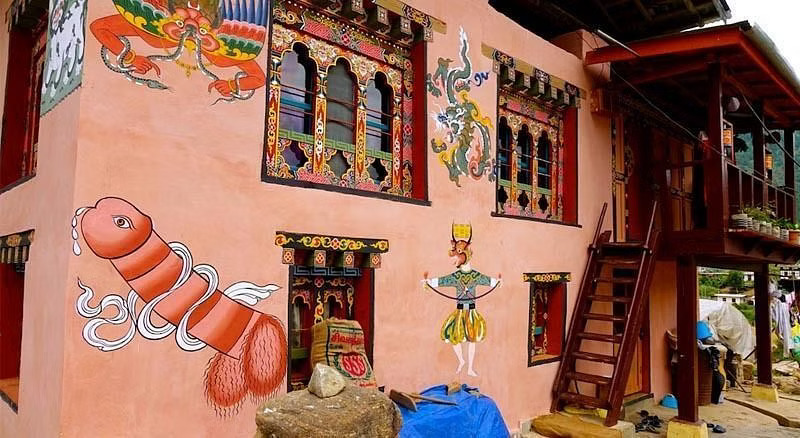
Transcending Taboos: Exploring the Curious World of Bhutanese Phallus Worship
Bhutan, a tiny nation nestled among the highest crests of the mighty Himalayas, draws in visitors from all over the world with its stunning landscapes and rich cultural heritage. Known as the ‘Land of the Thunder Dragon’, it is a country rich with sceneries of snow-capped peaks and winding roads. Its culture is steeped in Buddhism. Monasteries, temples, and stupas are scattered throughout the nation, and the sounds of Buddhist prayer chants reverberate through the valleys, However, there is more to Bhutan – beyond the popular image of monasteries, prayer flags, and serenity, lies a lesser-known aspect of Bhutanese culture.
As one explores the idyllic countryside of Bhutan, an unexpected and intriguing spectacle captures the attention. Intricate phallus symbols greet you from every corner – dangling from rooftops, embellishing doorways, painted onto the walls of homes, and featured in window displays. These phallic depictions are often ornate and colourful, coming in a variety of shades and drawn in great detail – some even shown to be ejaculating, while others have dragon imagery painted alongside them.
To the people of Bhutan, the symbol of the penis is a lucky talisman. Monks partake in a sacred ritual to bless homes, involving a procession where they carry a wicker basket filled with wooden phallic symbols. These symbols are believed to bring prosperity and good health to the families residing there. Additionally, they serve as powerful amulets, believed to protect the household from evil spirits and obstacles.
The popularity of these symbols begs the question – how did a symbol that outwardly appears to be in such stark contrast of a culture so steeped in spirituality and serenity come to be such a widely embraced part of it?
History
The answer to Bhutan’s deep fascination with phallic drawings lies in the country’s religious history and spiritual beliefs. Specifically, it goes back to one Tibetan Buddhist monk, or ‘lama’, from the 15th century – Drukpa Kunley, a man as enigmatic and unique as the symbols associated with him today.
Legend has it that Drukpa Kunley once shot an arrow from Tibet to signal a new place for disseminating his teachings. This arrow landed near present-day Chimi Lhakhang in the city of Punakha in Bhutan. During his travels across the kingdom, Drukpa Kunley learned of the strict ways of the clergy, who staunchly adhered to orthodox societal norms. Determined to liberate people from these constraints, he embarked on a mission to spread the authentic teachings of Buddha. His unconventional behaviour, including philandering and sexual overtones, earned him his moniker of the ‘Divine Madman’. Using bawdy poetry, titillating humour, and wine-induced sermons, he purposefully shocked people, encouraging them to question the established norms and challenge traditional customs. Drukpa Kunley’s actions were often considered shocking and controversial. He engaged in acts like urinating on sacred Buddhist paintings, using coarse language in his sermons through metaphors and allusions, and even offering sacred scarves with his penis. Additionally, he was known to engage in sexual acts with women regularly and indulge in alcohol, which contradicted the traditional image of a monk.
Cultural Significance
These unorthodox behaviours challenged societal norms and reflected his unconventional approach to spirituality and teaching.
In Punakha, today lies Chimi Lhakhang Temple, also known as the “Fertility Temple”. It houses a meditation hall constructed by Drukpa Kunley himself. The temple’s history dates back to Drukpa Kunley’s visit to the area. Tales of a demoness named Loro Duem drew the lama to the area, and as the legend goes, he used his “Flaming Thunderbolt Of Wisdom” – a euphemism he used to refer to his penis – to drive away a demoness named Loro Duem. The temple lies over her grave. Its architecture showcases ancient Thai-themed design adorned with phallus paintings and carvings, believed to bring luck, prosperity, and ward off evil. Visitors from around the world come to witness the unique traditional and cultural ceremonies performed at this temple. Chimi Lhakhang houses various phallic objects made of stone, bamboo, and ivory, attributed to the Divine Madman. These objects have a historical significance in blessing childless women, and some couples even spend the night at the temple seeking fertility blessings. Expecting mothers also visit the temple to seek protection for their unborn child or the well-being of their existing children.
It was this legend of Drukpa Kunley that brought about the Contemporary Bhutanese belief of viewing the phallus as a protective symbol capable of warding off evil spirits and obstacles. His unorthodox approach to teaching spirituality left a lasting impact on Bhutanese culture and the relevance of the phallus motif lives on today. Phalluses are painted on house walls, especially at the entrance, and placed on rooftops, pointing to the four cardinal directions. A variety of penis-shaped souvenirs adorn the shelves of shops in the form of paperweights, keychains and so on. These phallic symbols also find their place on necklaces, in granaries, and even in fields, serving as a form of scarecrow. Masked jesters incorporate them into religious festivals and are used as a blessing for fertility in temples.
Conclusion
The phallic symbols in Bhutanese culture go beyond their surface meanings. What in mainstream culture is often seen as either comedic or vulgar, in this unique aspect of Bhutanese culture they symbolise protection, warding off evil spirits, and transcending shame and guilt. In the same vein, embracing our own identities and discussing sensitive topics openly can liberate us from the constraints of societal judgement.
The captivating legend of Drukpa Kunley and Bhutanese phallus worship may at first look like nothing more than a unique and quirky tale of Bhutanese folklore. However, examining it further reveals certain lessons that have much relevance in today’s world. Just as Drukpa Kunley challenged the Bhutanese clergy’s conservative beliefs and strict societal norms, we, too, can draw inspiration from his fearless approach to question and challenge conventional thinking.
In contemporary society, where conversations about sexuality are often faced with discomfort and treated as taboo, Bhutan’s unapologetic celebration of phallic symbols inspires us to foster sex positivity and open discussions regarding sexuality, even in conservative cultural environments.
Author



